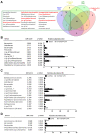Dual-Hit Model of Parkinson's Disease: Impact of Dysbiosis on 6-Hydroxydopamine-Insulted Mice-Neuroprotective and Anti-Inflammatory Effects of Butyrate
- PMID: 35742813
- PMCID: PMC9223521
- DOI: 10.3390/ijms23126367
Dual-Hit Model of Parkinson's Disease: Impact of Dysbiosis on 6-Hydroxydopamine-Insulted Mice-Neuroprotective and Anti-Inflammatory Effects of Butyrate
Abstract
Recent evidence highlights Parkinson's disease (PD) initiation in the gut as the prodromal phase of neurodegeneration. Gut impairment due to microbial dysbiosis could affect PD pathogenesis and progression. Here, we propose a two-hit model of PD through ceftriaxone (CFX)-induced dysbiosis and gut inflammation before the 6-hydroxydopamine (6-OHDA) intrastriatal injection to mimic dysfunctional gut-associated mechanisms preceding PD onset. Therefore, we showed that dysbiosis and gut damage amplified PD progression, worsening motor deficits induced by 6-OHDA up to 14 days post intrastriatal injection. This effect was accompanied by a significant increase in neuronal dopaminergic loss (reduced tyrosine hydroxylase expression and increased Bcl-2/Bax ratio). Notably, CFX pretreatment also enhanced systemic and colon inflammation of dual-hit subjected mice. The exacerbated inflammatory response ran in tandem with a worsening of colonic architecture and gut microbiota perturbation. Finally, we demonstrated the beneficial effect of post-biotic sodium butyrate in limiting at once motor deficits, neuroinflammation, and colon damage and re-shaping microbiota composition in this novel dual-hit model of PD. Taken together, the bidirectional communication of the microbiota-gut-brain axis and the recapitulation of PD prodromal/pathogenic features make this new paradigm a useful tool for testing or repurposing new multi-target compounds in the treatment of PD.
Keywords: antibiotic-induced intestinal injury; gut microbiota; neurodegenerative disorders; neuroinflammation; short-chain fatty acids.
Conflict of interest statement
The authors declare no conflict of interest.
Figures







References
-
- Chen H., Burton E.A., Ross G.W., Huang X., Savica R., Abbott R.D., Ascherio A., Caviness J.N., Gao X., Gray K.A., et al. Research on the premotor symptoms of Parkinson’s disease: Clinical and etiological implications. Environ. Health Perspect. 2013;121:1245–1252. doi: 10.1289/ehp.1306967. - DOI - PMC - PubMed
MeSH terms
Substances
LinkOut - more resources
Full Text Sources
Medical
Research Materials
Miscellaneous

